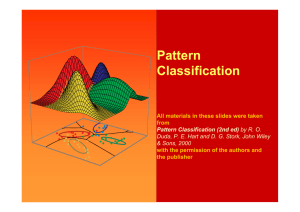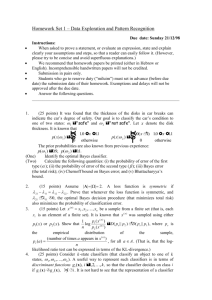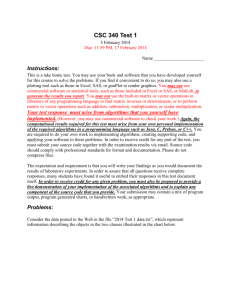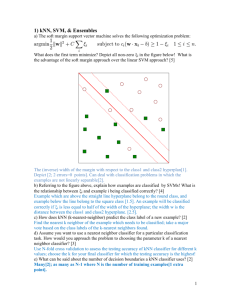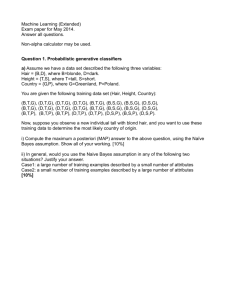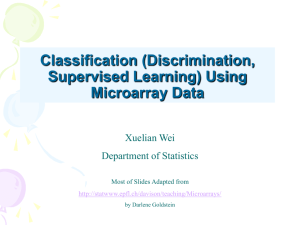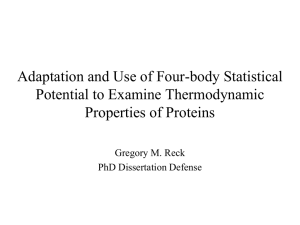Chap 3 Single-Layer Perceptron Classifiers
advertisement
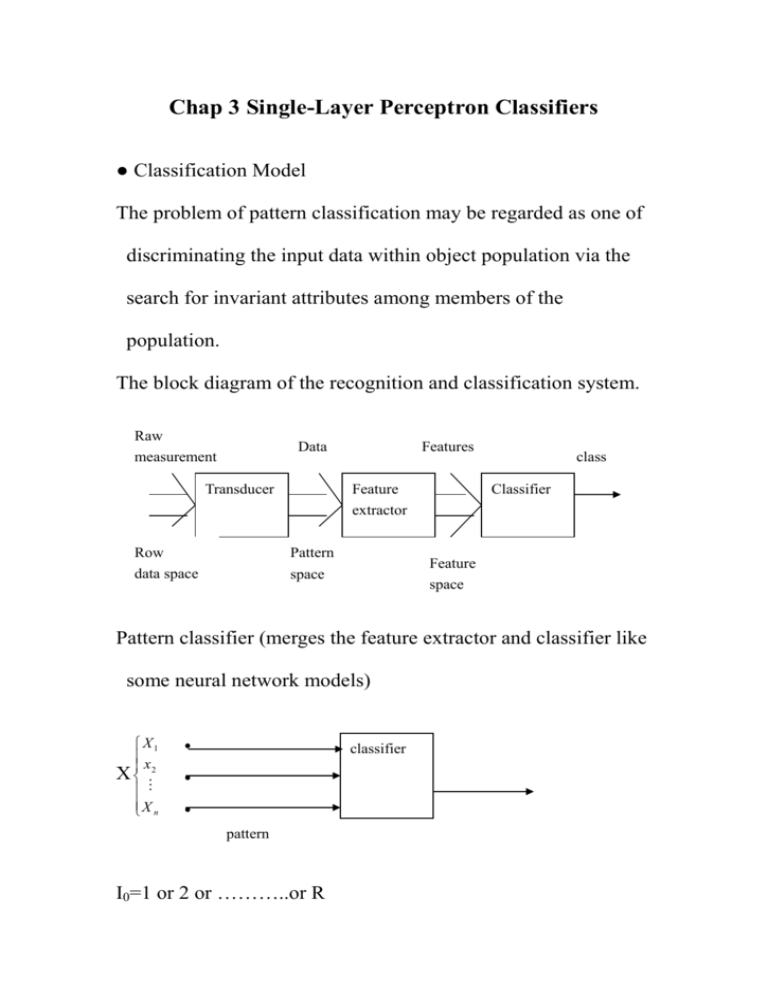
Chap 3 Single-Layer Perceptron Classifiers ● Classification Model The problem of pattern classification may be regarded as one of discriminating the input data within object population via the search for invariant attributes among members of the population. The block diagram of the recognition and classification system. Raw measurement Data Transducer Row data space Features Feature extractor Pattern space class Classifier Feature space Pattern classifier (merges the feature extractor and classifier like some neural network models) X1 x X 2 X n classifier pattern I0=1 or 2 or ………..or R Features: the compressed data from the transducer Feature extractor: performs the reduction of dimensionality Two simple ways of coding patterns into pattern vectors (see Figure 3.2): (a) spatial object and (b) temporal object For spatial object io i0 ( X ) where x x1 , x2 , xn t For temporal object io i0 ( X ) where x f (t1 ), f (t2 ),, f (tn ) The pattern space is a n dimension Euclidean space En ●Decision Regions æ1 g1(X)>g3(X) patterns of class 1 X2 æ4 n=2, R=4 (-10, 10) (20,10) (4,6) number of classes Patterns inside decision regions æ1 X1 æ3 æ2 Patterns on decision surfaces The decision function for a pattern of class j i0(X)=j for all X æj ,j=1,2,3,4 For space En, decision surfaces may be (n-1) dimensional hypersurfaces. ● Discriminant Functions During the classification step, the membership in a category needs to be determined by the classifier based on the comparison of R discriminant functions g1(X), g2(X),….,gR(x),where gi(X) are scalar values. The pattern X belongs to the i’th category, iff gi(X)>gj(X), for i,j =1,2,…..R, i j The discriminant functions gi(x) and gj(x) for contiguous decision regions æi and æj define the decision surface between patterns of classes i and j in En space: gi(X)-gj(X)=0 Ex: six sample patterns, n=R=2 0,0 , 2,0 , t t 0.5,1t , 1,2t : class 1 1.5,1t , 1,2t : class 2 Let g(X)=-2X1+X2+2 X2 g(X)>0 æ1 g(X)=X2-2X1+2=0 (0,0) (2,0) æ2 X1 1 ( ,1) 2 3 ( ,1) 2 (1,-2) (-1,-2) Decision Surface g(X)<0 The classifier into R=2 classes is called the dichotomizer. The general classification condition for the case of a dichotomizer can now be reduced to the inspection of the sign of the following discriminant function g(X)=g1(X)-g2(X) g(X)>0 : class 1 g(X)<0 : class 2 A single threshold logic unit (TLU) can be used to build such a simple dichotomizer. The TLU with weights has been introduced in Chap 2 as the discrete binary perceptron. i0 Discriminator 1 X i0 g(X) pattern g(x) 0 g -1 Discriminant 1 i0 sgn g ( X ) undefined 1 for g(X) 0 for g(X) 0 for g(X) 0 category Once a general function form of the discriminant function has been suitably chosen, discriminants can be computed using a priori information about the classification of patterns and their membership in classes. ● Linear Machine and Minimum Distance Classification In general, an efficient classifier has nonlinear discriminant functions of the inputs X1,X2,…..Xn. g1(X) g1(X) 1 g2(X) g2(X) 1 2 2 Maximum selector X gR(X) i0 category gR(X) R R The use of nonlinear discriminant functions can be avoided by changing the classifier’s feedforward architecture to the multilayer form. In the linear classification case, the decision surface is a hyperplane. For example, two clusters of patterns with the respective center points x1, x2 (vectors). The center points can be interpreted as centers of gravity for each cluster. We prefer that the decision hyperplane contains the midpoint of the line segment connecting prototype points p1 and p2 and it should be normal to the vector x1-x2.Therefore,the decision hyperplane equation is (App. A36) X t 1 X X2 1 2 X 2 2 X1 2 0 W1 X 1 W2 X 2 | Wn X n Wn1 0 t or W X Wn 1 0 t W X 0 Wn1 1 W X1 X 2 1 2 Wn1 X 2 X1 2 2 In the case of R pairwise separable classes, there will be up to R(R-1)/2 decision hyperplans. For R=3, there are up to three decision hyperplanes. Assume that a minimum-distance classification is required to classify patterns into one of the R categories The Euclidean distance between input pattern x and the prototype pattern vector Xi is t x X i X X i X Xi 2 X X i X t X 2 X it X X it X i , f o ir 1 , 2 , . R. . . . , independent of i choose the smallest one The discriminant function 1 g i ( X ) X i X X it X i , for i 1,2,....., R 2 g i ( X ) Wi t X Wi ,n 1 , for i 1,2,...........R Wi X i 1 Wi ,n 1 X it X i , i 1,2,........., R 2 minimum-distance classifiers can be considered as linear classifiers, sometimes, called linear machines. A linear classifier g1(X) W11 W12 1 W1,n+1 1 W21 W22 1 g2(X) W2,n+1 2 Maximum Selector X WR1 gR(X) WR2 R WR,n+1 1 Ex: A linear (minimum-distance) classifier the prototype points i0 Response 10 2 5 X 1 , X 2 , X 3 2 5 5 sol : R3 1 Wi X i , Wi,n 1 X it X i , i 1,2,3 2 10 2 5 W1 2 , W2 5 , W3 5 52 14.5 25 § Nonparametric Training Concept The sample pattern vectors X1,X2,………,Xp, called the training seguence, are presented to machine along with the correct response. The classifier modifies its parameters by means of iterative, supervised learning and its structure is usually adjusted after each incorrect response based on the error value generated. The adaptive linear binary classifier and its perceptron training algorithm. The decision surface equation in n-dimensional pattern space is WtX+Wn+1=0 The rewritten equation in the angmented weight space En+1 is Wty=0 a decision hyperplane in angmented weight space. This hyperplane always intersects the origin. Its normal vector, which is perpendicular to the plane, is the pattern y. Ex: Five prototype patterns of two classes (Fig 3.11) the normal vector will always point toward the side of the space for which Wty>0, called the positive side. We look for the intersection of the positive decision regions due to the prototypes of class 1 and of the negative decision regions due to the prototypes of class 2. The linear discriminant functions g1 ( X ) 10 X 1 2 X 2 52 g 2 ( X ) 2 X 1 5 X 2 14.5 g 3 ( X ) 5 X 1 5 X 2 25 S12 : 8 X 1 7 X 2 37.5 0 S13 : 15 X 1 3 X 2 27 0 S 23 : 7 X 1 10 X 2 10.5 0 g3 (X)>gi(X), i=1,2 S13 g1 (X)>gi(X) , i=2,3 P3(-5,5) æ1 æ3 S123 P1(2,-5) 0 S23 æ2 P2(2,-5) S12 g2 (X)>gi(X) , i=1,3 If R linear functions of gi(X)>gj(X) for all X X exist such that æi, i=1,2,…….R j=1,2,……..R, i j then the pattern sets æi are linearly separable. Examples of linearly nonseparable patterns (R=2) X2 1 -1 0 1 -1 class 1 class 2 X1
